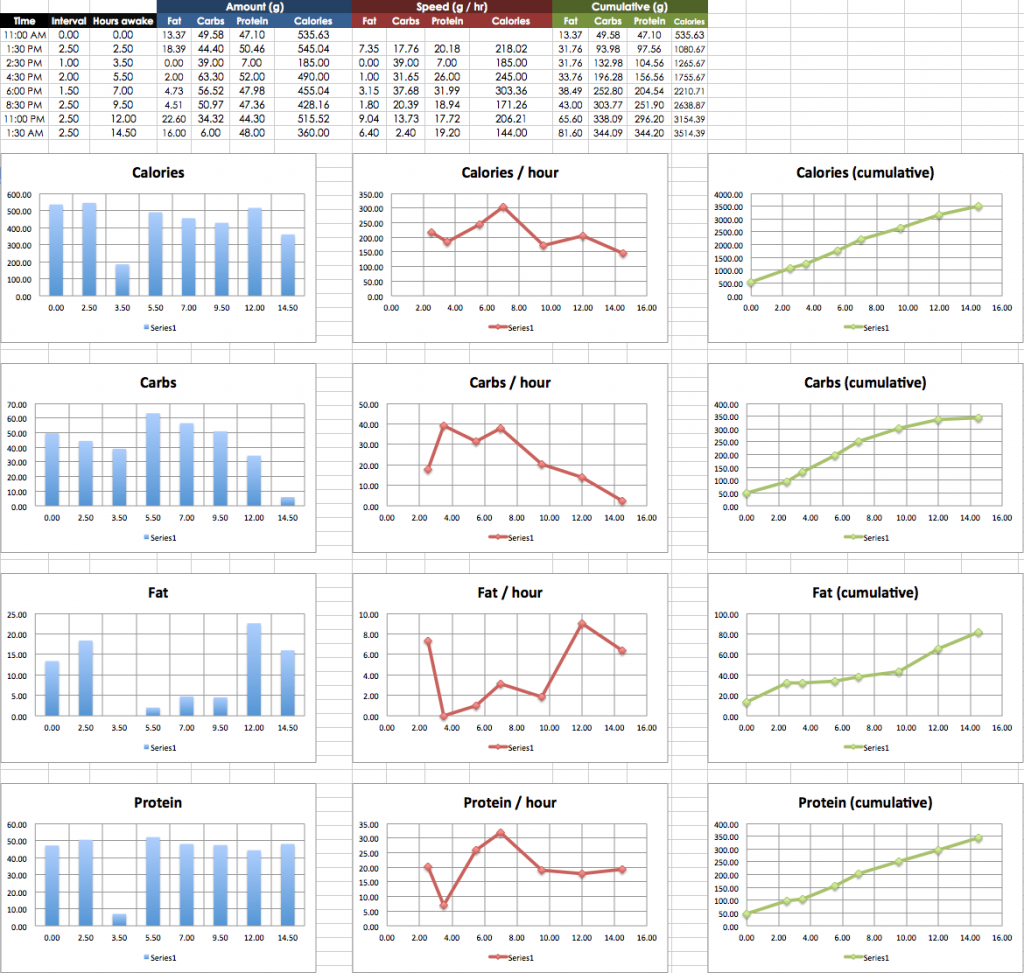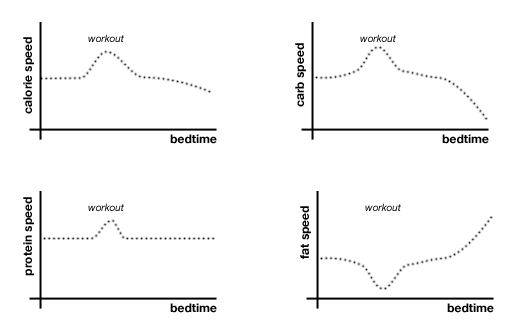Timing is everything. Steep tea a minute too long and you’ll ruin it. Start your business next year and you’ll miss the market. Kiss her now or forever regret the moment. Success in dieting, like success in life, requires an acute awareness of timing and opportunity. When you eat matters just as much as what you eat.
It’s not as simple as “calories in, calories out”, the facile explanation often used to sum up weight loss. Your body is a complex energy system with dynamically changing needs. A good diet plan will try to match resources to needs (e.g. eating more carbs before a workout), pair foods to produce the right synergistic effects (e.g. taking creatine with fruit juice), and capitalize on windows of opportunity (e.g. drinking protein right after a workout).
A good dieter learns to tango with their body – anticipating its next move, feeling out its desires, and stepping to its natural rhythms.
Visualizing Your Diet
My diet plan helps me track what I eat and how much to eat. But I also wanted a way to visualize the rhythms of my diet so that I could pace my consumption of various nutrients. So I graphed my cumulative intake of fat, carbs, and protein throughout the day, as well as my speed of intake:
If you follow a diet plan, I highly recommend visualizing your consumption this way. It’s a great way to reveal any imbalances in pacing.
Finding the Right Tempo
So what should a healthy consumption graph look like? Well this will highly depend on what your schedule looks like and how active you are. If you are Michael Phelps, it will probably look like the Himalayas. But for us humans who don’t eat a 12,000 calorie diet, aren’t professional athletes, and work out once a day around noon, it might look something like this:
Here are some general guidelines:
Carbs – Space your carbohydrates evenly throughout the day, increasing it before and after a workout, then taper it off towards bedtime when your metabolism slows down. Eating a high carb meal right before bed is a great way to get fat.
Protein – Your body should have a constant supply of protein all the way up til bedtime. Many bodybuilders even wake up in the middle of the night to drink a protein shake. Keep protein evenly spaced throughout the day, and increase it slightly right after a workout. I always have a meal of flaxseed oil and casein protein (digests slower than whey) right before bed.
Fat – Ideally, your fat intake should be inversely proportional to carb intake. Whenever you eat meals high in carbohydrates (especially if they are high GI foods), you’ll want to eat less fats to reduce the chance of your body storing it. In order to better isolate this variable, I eat 99% lean meats, then supplement with healthy fat sources like flaxseed oil, avocados, almonds, and fish oil.
Calories – This should look fairly similar to the carb graph. Increase calories before and after a workout, then taper off slightly towards bedtime. You don’t need to explicitly plan this. If you plan your carbs, protein, and fat correctly, the calories will fall into place.
Dancing to the beat
Are you feelin’ the beat? Now that we’re head bobbing to the right tempos, it’s time to start dancing (or fist pumping, whatever works). Go make some changes!
As soon as I graphed my diet, I realized I was working out too late. Since I usually hit the gym around 8pm, my three biggest meals were all crammed in late at night. My carb curve had an apex around 10pm. This also meant my body was wide awake at wee hours of the night, even though my brain wanted it to be asleep.
Once I started doing my heavy lifting in the afternoon, the curves started looking a lot more like the ideals I describe above. I was beginning to understand the rhythms of my body. I was finally learning to tango.



